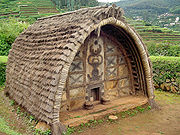
Indian vernacular architecture
Encyclopedia




The term "vernacular architecture
Vernacular architecture
Vernacular architecture is a term used to categorize methods of construction which use locally available resources and traditions to address local needs and circumstances. Vernacular architecture tends to evolve over time to reflect the environmental, cultural and historical context in which it...
" in general refers to the informal building of structures through traditional building methods by local builders without using the services of a professional architect. It is the most widespread form of building.
Categories
Indian vernacular architecture has evolved organically over time through the skillful craftsmanship of the local people. Despite the diversity, this architecture can be broadly divided into three categories.kachcha
A kachcha is a building made of natural materials such a mudMud
Mud is a mixture of water and some combination of soil, silt, and clay. Ancient mud deposits harden over geological time to form sedimentary rock such as shale or mudstone . When geological deposits of mud are formed in estuaries the resultant layers are termed bay muds...
, grass
Grass
Grasses, or more technically graminoids, are monocotyledonous, usually herbaceous plants with narrow leaves growing from the base. They include the "true grasses", of the Poaceae family, as well as the sedges and the rushes . The true grasses include cereals, bamboo and the grasses of lawns ...
, bamboo
Bamboo
Bamboo is a group of perennial evergreens in the true grass family Poaceae, subfamily Bambusoideae, tribe Bambuseae. Giant bamboos are the largest members of the grass family....
, thatch or sticks and is therefore a short-lived structure. Since it is not made for endurance it requires constant maintenance and replacement. The practical limitations of the building materials available dictate the specific form which can have a simple beauty. The advantage of a kachcha is that construction materials are cheap and easily available and relatively little labor is required.
pukka
A pukka is a structure made from materials resistant to wear, such as forms of stone or brick, clay tiles, metal or other durable materials, sometimes using mortarMortar (masonry)
Mortar is a workable paste used to bind construction blocks together and fill the gaps between them. The blocks may be stone, brick, cinder blocks, etc. Mortar becomes hard when it sets, resulting in a rigid aggregate structure. Modern mortars are typically made from a mixture of sand, a binder...
to bind, that does not need to be constantly maintained or replaced. However, such structures are expensive to construct as the materials are costly and more labor is required. A pukka may be elaborately decorated in contrast to a kachcha.
semi-pukka
A combination of the kachcha and pukka style, the semi-pukka, has evolved as villagers have acquired the resources to add elements constructed of the durable materials characteristic of a pukka. Architecture as always evolves organically as the needs and resources of people change.Regional variation
Building material depends on location. In hilly country where rocky rubble, ashlarAshlar
Ashlar is prepared stone work of any type of stone. Masonry using such stones laid in parallel courses is known as ashlar masonry, whereas masonry using irregularly shaped stones is known as rubble masonry. Ashlar blocks are rectangular cuboid blocks that are masonry sculpted to have square edges...
, and pieces of stone are available, these can be patched together with a mud mortar to form walls. Finer stonework veneer covers the outside. Sometimes wood beams and rafters are used with slate tiles for roofing if available. Houses on hills usually have two stories, with the livestock living on the ground floor. Often a verandah
Verandah
A veranda or verandah is a roofed opened gallery or porch. It is also described as an open pillared gallery, generally roofed, built around a central structure...
runs along the side of the house. The roof is pitched to deal with the monsoon season and the house may sit on raised plinths or bamboo poles to cope with floods.
On the flat lands, abodes are usually made of mud or sun-baked bricks, then plastered inside and out, sometimes with mud mixed with hay or even cow dung and whitewashed with lime.
Where bamboo is available (mainly in the north and northeastern states) it is widely used for all parts of the home as it is flexible and resilient. Also widely used is thatch from plants such as elephant grass, paddy, and coconut. In the south, clay tiles are used for pukka roofing while various plant material such as coconut palm is common for kachcha.

